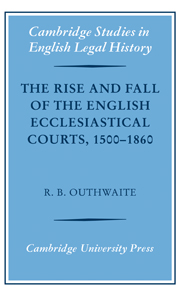Book contents
- Frontmatter
- Contents
- Foreword by R. H. Helmholz
- Preface
- Table of parliamentary statutes
- List of abbreviations
- 1 The ecclesiastical courts: structures and procedures
- 2 The business of the courts, 1500–1640
- 3 Tithe causes
- 4 Wills and testamentary causes
- 5 Defamation suits
- 6 Marital suits and marriage licences
- 7 Office causes
- 8 The roots of expansion and critical voices
- 9 Charting decline, 1640–1830
- 10 Explaining decline
- 11 The bills of 1733–1734
- 12 Snips and repairs: small steps to reform, 1753–1813
- 13 Royal commissions and early fruits, 1815–1832
- 14 Reform frustrated
- 15 Reforms thick and fast, 1854–1860
- Select bibliography
- Index
1 - The ecclesiastical courts: structures and procedures
Published online by Cambridge University Press: 21 January 2010
- Frontmatter
- Contents
- Foreword by R. H. Helmholz
- Preface
- Table of parliamentary statutes
- List of abbreviations
- 1 The ecclesiastical courts: structures and procedures
- 2 The business of the courts, 1500–1640
- 3 Tithe causes
- 4 Wills and testamentary causes
- 5 Defamation suits
- 6 Marital suits and marriage licences
- 7 Office causes
- 8 The roots of expansion and critical voices
- 9 Charting decline, 1640–1830
- 10 Explaining decline
- 11 The bills of 1733–1734
- 12 Snips and repairs: small steps to reform, 1753–1813
- 13 Royal commissions and early fruits, 1815–1832
- 14 Reform frustrated
- 15 Reforms thick and fast, 1854–1860
- Select bibliography
- Index
Summary
People's lives are regulated by custom and by law, enlivened by flashes of wilfulness that might well get them into trouble. Men and women in the three-and-a-half centuries examined here functioned within various social units – households, kinship groups, manors, parishes, villages, towns, gilds – all of which had formal and informal rules governing behaviour and imposing sanctions on those who had misbehaved. This book is not concerned, however, with informal rules and informal sanctions, important though these are, but with those formal rules and formal sanctions that were dispensed by courts of justice, operating in acknowledged systems of law.
There were two overarching systems of law operating in the early modern period, one secular or temporal and the other spiritual. Temporal law was dispensed in manorial, hundred and borough courts, in petty and quarter sessions, in assizes and in the royal courts situated in London – the Court of Common Pleas, the Court of Requests, the King's Bench and so on. Spiritual law – our concern – was dispensed through hundreds of ecclesiastical courts scattered the length and breadth of the country. How many there were is difficult to establish. Hill, reviewing their operations in the sixteenth and early seventeenth centuries, put their number at over 250. A parliamentary report of 1832 stated that there were 372 courts, of which 285 were ‘peculiars’ in ecclesiastical districts that were exempt from the oversight of the bishops in whose dioceses they were geographically situated.
- Type
- Chapter
- Information
- Publisher: Cambridge University PressPrint publication year: 2007



